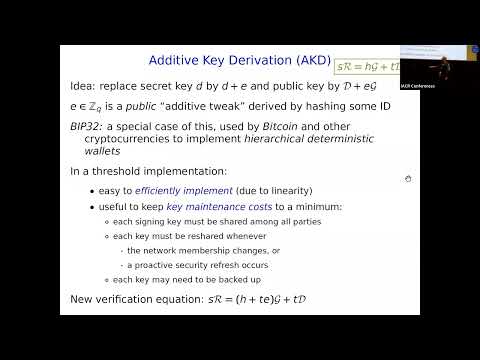CryptoDB
On the security of ECDSA with additive key derivation and presignatures
| Authors: |
|
|---|---|
| Download: | |
| Presentation: | Slides |
| Conference: | EUROCRYPT 2022 |
| Abstract: | Two common variations of ECDSA signatures are {\em additive key derivation} and presignatures. Additive key derivation is a simple mechanism for deriving many subkeys from a single master key, and is already widely used in cryptocurrency applications with the Hierarchical Deterministic Wallet mechanism standardized in Bitcoin Improvement Proposal 32 (BIP32). Because of its linear nature, additive key derivation is also amenable to efficient implementation in the threshold setting. With presignatures, the secret and public nonces used in the ECDSA signing algorithm are precomputed. In the threshold setting, using presignatures along with other precomputed data allows for an extremely efficient "online phase" of the protocol. Recent works have advocated for both of these variations, sometimes combined together. However, somewhat surprisingly, we are aware of no prior security proof for additive key derivation, let alone for additive key derivation in combination with presignatures. In this paper, we provide a thorough analysis of these variations, both in isolation and in combination. Our analysis is in the generic group model (GGM). Importantly, we do not modify ECDSA or weaken the standard notion of security in any way. Of independent interest, we also present a version of the GGM that is specific to elliptic curves. This EC-GGM better models some of the idiosyncrasies (such as the conversion function and malleability) of ECDSA. In addition to this analysis, we report security weaknesses in these variations that apparently have not been previously reported. For example, we show that when both variations are combined, there is a cube-root attack on ECDSA, which is much faster than the best known, square-root attack on plain ECDSA. We also present two mitigations against these weaknesses: re-randomized presignatures and homogeneous key derivation. Each of these mitigations is very lightweight, and when used in combination, the security is essentially the same as that of plain ECDSA (in the EC-GGM). |
Video from EUROCRYPT 2022
BibTeX
@inproceedings{eurocrypt-2022-31830,
title={On the security of ECDSA with additive key derivation and presignatures},
publisher={Springer-Verlag},
author={Victor Shoup and Jens Groth},
year=2022
}

